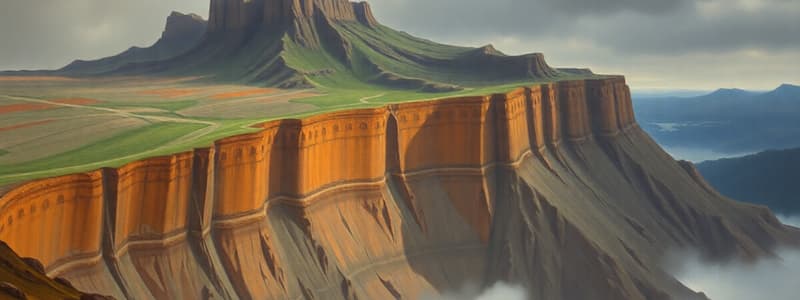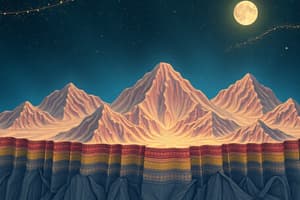Podcast
Questions and Answers
Which of the following statements accurately describes the relationship between the lithosphere and the asthenosphere?
Which of the following statements accurately describes the relationship between the lithosphere and the asthenosphere?
- The lithosphere is a layer of swirling magma, while the asthenosphere consists of rigid plates.
- The lithosphere is composed of the crust and upper mantle, while the asthenosphere is a region of convection in the mantle. (correct)
- The lithosphere is primarily composed of granite, while the asthenosphere is composed of basalt.
- The lithosphere and asthenosphere are both liquid layers within the Earth's core.
At a convergent boundary where an oceanic plate meets a continental plate, which of the following processes is most likely to occur?
At a convergent boundary where an oceanic plate meets a continental plate, which of the following processes is most likely to occur?
- The oceanic plate sub ducts under the continental plate due to its higher density. (correct)
- Both plates uplift to create a mountain range without subduction.
- The continental plate sub ducts under the oceanic plate due to its higher density.
- The two plates slide past each other, resulting in strike-slip faults.
Which of the following is a direct result of magma rising to fill the gap created at a divergent plate boundary?
Which of the following is a direct result of magma rising to fill the gap created at a divergent plate boundary?
- The formation of strike-slip faults.
- The creation of underwater mountain ranges as the magma cools and hardens. (correct)
- The subduction of one plate beneath another.
- The formation of deep ocean trenches.
Which of the following processes is most directly associated with the movement of tectonic plates?
Which of the following processes is most directly associated with the movement of tectonic plates?
The San Andreas Fault in California is an example of which type of plate boundary?
The San Andreas Fault in California is an example of which type of plate boundary?
What geological feature is commonly associated with a hot spot?
What geological feature is commonly associated with a hot spot?
Why do soils overlying igneous rock tend to have a lower pH compared to soils overlying limestone?
Why do soils overlying igneous rock tend to have a lower pH compared to soils overlying limestone?
How does the density of basalt compare to the density of granite, and where are these rock types typically found in the Earth's crust?
How does the density of basalt compare to the density of granite, and where are these rock types typically found in the Earth's crust?
How can underwater volcanoes (seamounts) contribute to the formation of volcanic island arcs?
How can underwater volcanoes (seamounts) contribute to the formation of volcanic island arcs?
What role does calcium carbonate (CaCO3) play in soils overlying limestone, and how does it affect the soil's pH stability?
What role does calcium carbonate (CaCO3) play in soils overlying limestone, and how does it affect the soil's pH stability?
Flashcards
Lithosphere
Lithosphere
The solid, rocky outer layer of the Earth, consisting of the crust and the uppermost part of the mantle.
Asthenosphere
Asthenosphere
Upper mantle that moves in a slow, creeping motion.
Divergent Boundaries
Divergent Boundaries
Plates move away from each other, magma rises to fill the gap.
Subduction zone
Subduction zone
Signup and view all the flashcards
Trenches and Cracks
Trenches and Cracks
Signup and view all the flashcards
Transform Boundaries
Transform Boundaries
Signup and view all the flashcards
Hot Spot Volcanoes
Hot Spot Volcanoes
Signup and view all the flashcards
Igneous Rocks Formation
Igneous Rocks Formation
Signup and view all the flashcards
Sedimentary Rock Formation
Sedimentary Rock Formation
Signup and view all the flashcards
Metamorphic Rock Formation
Metamorphic Rock Formation
Signup and view all the flashcards
Study Notes
- Earth's layers include a solid crust, a liquid outer core, a solid inner core, and the mantle, which has the athenosphere and lithosphere layers
Convection
- Convection moves substances based on temperature
- Convection in the mantle involves warm magma rising and cooler magma falling, creating a slow, creeping motion
Lithosphere and Athenosphere
- The lithosphere is composed of the crust and the upper part of the mantle and is rigid, forming plates
- The athenosphere contains swirling magma and is responsible for convection
- The upper mantle's movement breaks the lithosphere into plates, which then move
Plate Boundaries
- Magma movement causes plates to push against each other
- Oceanic crust is basalt and continental crust is granite
- Basalt is denser than granite
Convergent Plate Boundaries
- Oceanic crust (basalt) is denser and subducts below continental crust (granite) at ocean-continent boundaries, creating deep trenches and cracks
- These cracks can lead to volcanoes where magma seeps up
- Both plates of basalt subduct at ocean-ocean boundaries because one older plate is more dense from more sediments.
- This subduction can lead to underwater volcanoes (seamounts) that release magma, hardening and accumulating, and can grow to become volcanic island arcs
- At continental-continental boundaries, both granite plates push against each other, forming mountains
Earthquakes and Tsunamis
- Plates can get stuck and suddenly release, causing earthquakes and tsunamis
Divergent Plate Boundaries
- At ocean-ocean boundaries, crust is pulled apart and magma rises to fill in the gap, hardening and creating underwater mountain ranges
- Movement and erosion prevent the ridges from getting too tall
- Examples include mid-ocean ridges, Iceland, and the African Rift Valley
Transform Plate Boundaries
- Two plates slip past each other, causing earthquakes; example: San Andreas Fault in California
Volcano Types
- Volcano types include land, Volcanic Island arcs, and hotspots
Hot Spot Volcanoes
- Plates continue to move and create new seamounts and islands
Important Plate Locations
- Important plate locations include the Aleutian volcanic island arc in Alaska, Yellowstone in Wyoming, the San Andreas Fault in California, the Hawaiian Islands (hotspots), the Mid-Atlantic Ridge, the Himalayas, the African Rift Valley, and the Japan Volcanic Island Arc
Rock Cycle
- Igneous rock undergoes weathering and deposition to become sedimentary rock, and heat and pressure turns it into Metamorphic rock, melting then cooling and crystallizing the magma to make more Igneous rock
- Soils over igneous rock have higher fertility (NPK) and lower pH
- Soils over limestone are more stable due to the CaCO3 buffer, which resists pH change from acid rain
Studying That Suits You
Use AI to generate personalized quizzes and flashcards to suit your learning preferences.



